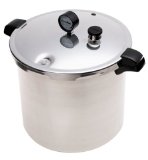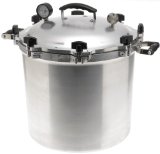Is it possible to set the dye on silk fabric or yarn using a large canning pressure cooker instead of a steamer?
Name: Angie
—ADVERTISEMENTS—
Pressure canners can correct for the lower temperature of steam at high altitudes.

Presto 01781 23-Quart Pressure Canner and Cooker

All-American 41-1/2-Quart Pressure Cooker/Canner

Linda Knutson's book
Synthetic Dyes
for Natural Fibers
provides a thorough
Country or region: Idaho mtns.
Message: Please tell me if it's possible to set the dye on silk fabric or yarn using a large canning pressure cooker instead of a steamer. Also, could I use a plastic Reynolds oven bag instead of all of the newsprint? What temperature is necessary for "steaming" to set silk dyes?
Some dyers do use a pressure cooker to steam silk. Normally I don't think it's the best way to steam, because the extremely high heat, potentially much hotter than the steam in a normal-pressure steamer, can harm the silk, resulting in uneven shininess, or in creases that are difficult or impossible to remove. If you're having trouble with high altitudes, however, I can understand why you're interested in the idea.
The purpose of the high pressure in a pressure cooker is to increase the maximum temperature that can be reached. At normal atmospheric pressure at sea level, the maximum temperature is 100°C (212°F), but at fifteen pounds pressure, the maximum temperature at sea level is 120°C (250°F). This temperature may be useful in dyeing polyester fabric without a dye carrier, but it is high enough to cause damage to silk. (You can, of course, use a pressure canner at regular atmospheric pressure, as long as you keep the pressure regulator open so that it does not build up pressure.)
If you decide to try steaming in a pressure cooker, I strongly advise you to use the lowest setting, and certainly not the fifteen pounds pressure maximum, when steaming silk. Note that the pressure regulator on pressure cookers is not always reliable when purchased, sometimes resulting in a higher pressure; I've heard that you can get your local county extension service office to check your pressure regulator for you, for free, since it's a safety issue.
The pressure cooker setting indicates how much higher its pressure is than the atmospheric pressure, so the temperature for a given setting will be lower at high altitude than it is for the same setting at sea level. At the mean elevation of Idaho, 5000 feet, the air pressure is 12.2 pounds per square inch, as opposed to 14.7 pounds per square inch at sea level. Ideally, to correct for the difference in pressure at this altitude, you would need to add 2.5 pounds per square inch, which is below the lowest setting provided by pressure cookers (which often have settings of 5, 10, and 15 pounds per square inch about the outside air pressure). At 10,000 feet altitude, the air pressure is 10.1 pounds per square inch, so the 5-pound setting should restore the boiling temperature, and the temperature of your steam, very nearly to what you would see at sea level.
As far as wrapping in plastic is concerned, it is essential, when you heat-set dyes in silk, that there be some moisture present for the reaction between the dye and the silk. (This is the opposite of silk paint, the acrylic binder in which is set with dry heat, using an iron or a hot commercial clothes dryer.) Newsprint paper allows the penetration of some of the water in the steam; when you wrap your silk in newsprint for steaming, you allow it to dry first. If you wish to wrap your silk in plastic, instead of paper, the silk should be damp during the steaming process, so as to provide some molecules of water to the dye/fiber reaction. In one way or another, you must provide moisture for this reaction. Obviously there will be limitations depending on what sort of design you are setting, since a wet piece of fabric is not likely to hold as finely detailed a line.
If you are going to use plastic to wrap your wet silk for steaming, then Reynolds oven bags are a very good choice, because they are so heat-resistant. Reynolds oven bags are made of a nylon that is supposed to be safe up to 400°F (or 200°C). Some plastics have a much lower melting point.
(Please help support this web site. Thank you.)
(Please help support this web site. Thank you.)
Posted: Monday - January 21, 2013 at 10:28 AM
Follow this blog on twitter here.
Quick Links
- All About Dyes & Dyeing Top -
- Top of this blog -
- FAQ -
- The Dye Forum -
- How to Tie Dye - How to Batik -
- Books - Toys - Plants -
- Top of this blog -
- FAQ -
- The Dye Forum -
- How to Tie Dye - How to Batik -
- Books - Toys - Plants -
More in this category:
- -
Statistics
Total entries in this blog:
Total entries in this category:
Published On: Jan 21, 2013 10:53 AM
Total entries in this category:
Published On: Jan 21, 2013 10:53 AM